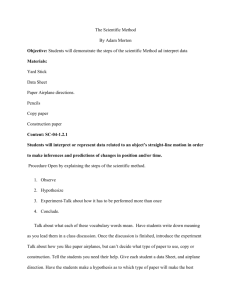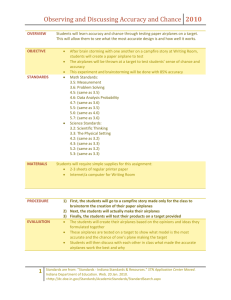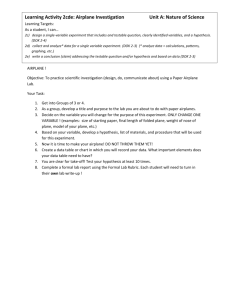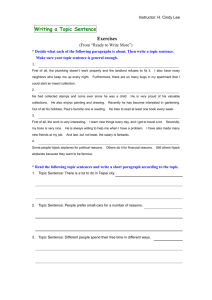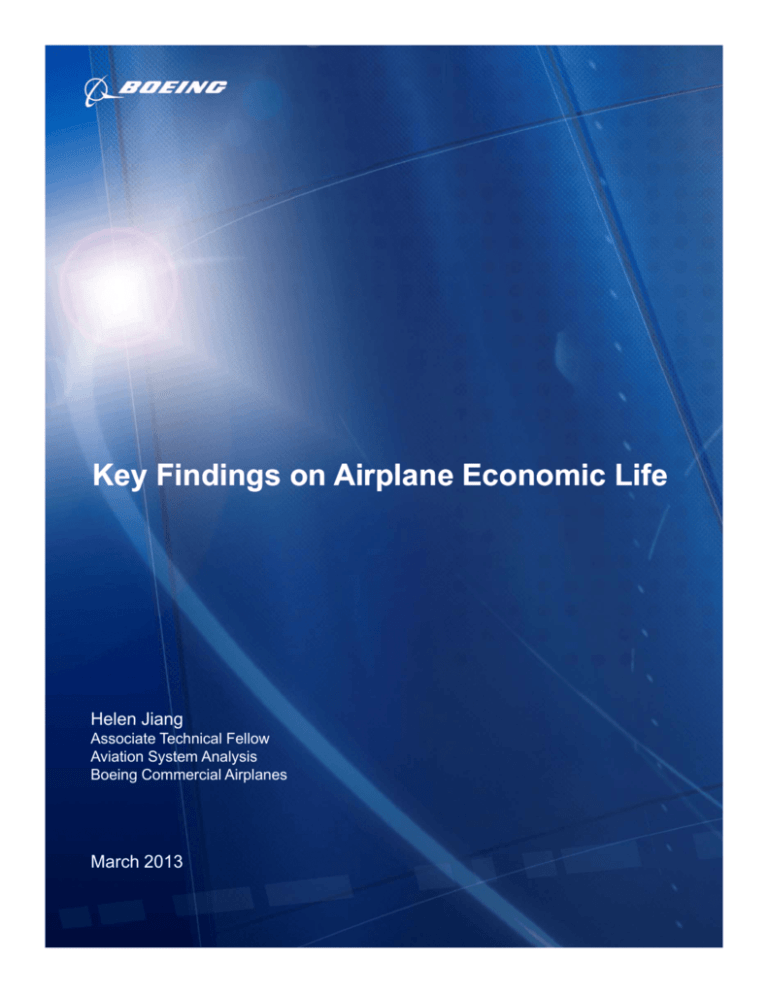
Key Findings on Airplane Economic Life
Helen Jiang
Associate Technical Fellow
Aviation System Analysis
Boeing Commercial Airplanes
March 2013
Key Findings on Airplane Economic Life
Boeing Commercial Airplanes
March 2013
About the Author
Helen Jiang is an aviation system analyst at Boeing Commercial Airplanes in Renton, Wash.,
where she and her teammates provide expertise in market analysis and research, forecasting,
modeling and simulation to support Boeing’s
Boeing s business
planning and production decisions. Trained as an aerospace
engineer in China, Jiang holds a master’s degree in aerospace engineering from MIT, and an MBA from the University
of Washington. She joined Boeing in 2005 after career work
in China as a strategy and airline analyst at both Aviation
Industry of China (AVIC) and Airbus Industrie China. Jiang
has particular expertise in survival analysis and holds a U.S.
patent on methodology for fleet and airplane retirement
forecasting. Her work earned her the distinction of being
named a Boeing Associate Technical Fellow in 2011.
Defining the Debate Parameters
The terms “airplane economic life”, “airplane useful life”, “airplane service life”, and a host of
variations on these terms occur frequently
q
y in industry
y literature and discussions. Within the
air transport industry there is a sense that we know what these terms refer to. Yet a recent
casual survey indicated that even experts are hard pressed to precisely define these terms
in a way that can be quantified. Further, analysts use a variety of surrogate measures as the
basis for quantifying airplane economic life. There is no industry standard for which
surrogate is appropriate for a particular context. This leaves room for considerable confusion
and misinterpretation of data when conclusions based on one surrogate are compared to
those based on another surrogate. Boeing conducted an in-depth study on airplane
economic life, in part to address recent speculation that the expected life span of the latest
generations of commercial airplanes may be declining. The following report summarizes our
findings on the use of terminology, the quantification of airplane economic life, and the
stability of airplane economic life spans.
Copyright © 2013 Boeing. All rights reserved.
2
Executive Summary
The terms airplane economic life, airplane useful life, and airplane service life, have appeared
frequently
q
y in the media and industry
y reports
p
recently.
y Speculation
p
or concern that the economic
life of modern commercial aircraft may be shortening lies at the heart of these discussions. A
significant shift in the life expectancy of commercial aircraft would have profound and longlasting impact on all players in the industry.
Boeing closely monitors the evolution of the commercial fleet and trends in airplane
retirements. Yet, in a recent exhaustive study, we did not identify a standard metric to quantify
airplane economic life. We observed that:
The concept of airplane economic life appears to be contextually defined, based on
multiple parameters specific to the entity making the assessment (e.g., airline business
model, fleet planning, geographical operation study, local economic factors, acquisition
timing, etc.).
Measures, such as the average age of airplanes when they are permanently withdrawn
f
from
service or the average age off in-service airplanes at the point in time when 50%
% off
an original cohort of airplanes has been retired, provide surrogate measures of airplane
economic life.
Further, our study revealed that whichever surrogate one chooses to measure airplane
economic life, the evidence suggests that the measure has remained stable for more than 15
years.
Moreover, fleet evolutions of the current-generation of airplanes, such as the Next Generation
737 and A320, are following the same trend as previous generations of airplanes. Boeing has
found no evidence of a meaningful change in airplane economic life over the last two decades,
or going forward.
Background
g
The Boeing study was rigorous and comprehensive in scope, covering all commercial jets –
31,032 units in total – that were built and delivered by western manufacturers since the start of
the jet age. Study data begins with delivery of the first de Havilland Comet in 1952 and tracks
the status of each individual aircraft “tail” annually from date of delivery until the year-end 2012.
The data source used was the Flightglobal Ascend database. A technical paper that elaborates
the data process and analysis results in depth will be available shortly
shortly.
Analysis
Our extensive research could not identify a standard metric that quantifies airplane
economic life.
One of our initial efforts set out to find a quantifiable definition of airplane economic life to be
used in the calculation. The example in the textbox below illustrates the challenge in this
seemingly straightforward quest. Although the International Society of Transport Aircraft
Trading (ISTAT) definition describes the concept, it does not specify how to formulate an
evaluation.
Copyright © 2013 Boeing. All rights reserved.
3
Example:
Given a cohort of 6 airplanes (all exactly the same and produced in the same year), having the following
status:
1. scrapped at 20 years old
2. scrapped at 22 years old
3. scrapped at 24 years old
4. scrapped at 26 years old
5. scrapped at 35 years old
6. flying at 36 years old
One can calculate:
The average age of this cohort is 27.2 years and growing, (20 + 22 + 24 + 26 + 35 + >36)/6. It is
important to note that the average age of this cohort will continue to grow as there is still one
airplane flying.
The average useful life of this cohort is 27.2 years and growing, the calculation is the same as
above.
The 50 percentile survival age is 24 years, at which half of the cohort is scrapped.
Question: How would you evaluate the economic life of this cohort?
LIFE, ECONOMIC USEFUL (from ISTAT Handbook)
As it pertains to an aircraft or engine, the economic useful life is the period of time over which
it is (or is expected to be) physically and economically feasible to operate it in its intended
role. Periodic maintenance and repair will usually be required in order to preserve safety and
efficiency
ffi i
d
during
i th
the economic
i useful
f l lif
life.
Concerning the definition and calculation of airplane economic life, we observed that:
The definition of airplane economic life must be deduced in the context of the report or
analysis at hand. Various industry entities, including airlines, airplane financiers, leasing
companies, airplane manufacturers, and aviation suppliers, use specialized definitions of
the concept, based on multiple parameters of interest specific to the entity (e.g., business
model, fleet planning, geographical operation factors, local economic conditions,
acquisition timing, etc.).
Either of two common surrogates for airplane economic life can be used to quantify the
concept: (1) the average age of airplanes when they are permanently withdrawn from
service; and (2) the interval of time between delivery of a cohort of airplanes and the date
when 50% (or some other fraction) of the cohort has been retired.
To ensure a meaningful quantitative analysis, it is imperative to specify which surrogate for
airplane economic life will be used.
Whichever surrogate one chooses as their measure of airplane economic life, our study
indicates that the measure has remained stable for more than 15 years.
Our study investigated all major surrogates commonly used in quantification of airplane
economic life. Representative examples of two popular formulations are presented below.
Copyright © 2013 Boeing. All rights reserved.
4
Exhibit 1 shows historical trend lines for airplane cohort survival rate between 1980 and 2012.
The vertical axis represents the number of years between delivery of a typical cohort of
airplanes and the date at which 50% of the airplanes in that cohort have been retired. Singleaisle cohorts are represented in light blue and twin
twin-aisle
aisle cohorts in dark blue
blue. The dotted lines
track the total surviving fleet, including in-service and parked airplanes. The solid lines track
just the revenue-generating fleet, which includes only in-service airplanes. As stated earlier,
each line shows that airplane retirements have remained stable for more than 15 years. In
analyzing data like this, one must always be cautious to ensure that nominal volatility in the
data does not indicate a trend line, so we carefully look at the long-term trends of the data.
Exhibit 1
Years since delivery reaching 50% survival
35
30
25
20
15
Single-Aisle In service & parked pax/frtr
Single-Aisle In service pax/frtr
10
Twin-Aisle In service & parked pax/frtr
5
Twin-Aisle In service pax/frtr
Note: Regional jets (90 seats and
below) are excluded.
0
1980
1985
1990
Copyright © 2013 Boeing. All rights reserved.
1995
2000
2005
2010
5
Exhibit 2 depicts the trends of the average age of single-aisle and twin-aisle airplanes that
have been permanently removed from commercial service. The solid lines represent the
average age at which the airplanes leave service. The dashed lines represent the average age
at which the airplanes are scrapped
scrapped. The difference between the solid lines and the dashed
lines reflects the time that the airplanes are in storage prior to being scrapped. The trend lines
show that the average airplane age at end of service has remained stable for more than 15
years, gradually increasing as technology advances have been implemented. Over time,
significant events, regulation and technology shifts have had impactful influence on the data,
although often over only limited periods. These help to explain some of the variation and data
noise in the trends observed. The decline in average age of retired airplanes over the last 2-3
23
years is very likely caused by the combined outcome of trend correction, impact of the Great
Recession, a weak cargo market, and parting-out some young airplanes. At present, the
industry is experiencing the initial wave of 737 Classic, MD80, and A320 retirements; and the
volume of 737 Classic and MD80 retirements echoes their delivery cycle. Consequently, the
average ages of passenger airplanes at the time of their leaving service and being scrapped
are likely to fluctuate as this wave passes through. Nonetheless, the pattern of their retirements
has behaved much the same as that of their predecessors, discussed in Exhibit 4 later.
Exhibit 2
Average Age (year)
40
35
30
25
Freighter age at scrapped
20
Freighter age at leaving service
15
Pax a/p excl. RJ age at scrapped
Pax a/p excl. RJ age at leaving service
10
1980
1985
1990
Copyright © 2013 Boeing. All rights reserved.
1995
2000
2005
2010
6
Exhibit 3 shows survival curves of major single-aisle passenger aircraft. The horizontal axis
represents the average fleet age, which includes all in-service, parked, and scrapped airplanes.
The vertical axis represents the surviving fleet as a percentage of total deliveries. Survival
curves for Boeing707
Boeing707, 727
727, and 737
737-100/200
100/200 demonstrate the impact of technology advances
on airplane economic life. Survival levels of 737 Classic and MD80/90 are about 70% at
present and their trajectories have followed trends of 727 and 737-100/200. As the fleets age,
the survival curves will extend to the right, eventually crossing the 50 percentile threshold.
Survival curves for Next Generation 737s and A320s are behaving like those of the previous
generation. Although the Next Generation 737s and the A320s are still quite young fleets, their
behavior, including a few retirements, are well within historical norms.
Exhibit 3
Survival fleet as % total deliveries
100%
90%
80%
707 Pax
70%
727 Pax
60%
737-100/200 Pax
50%
MD80/90 Pax
P
40%
737 Classic Pax
30%
757 Pax
20%
A320 Family Pax
10%
737NG Pax
0%
0
5
10
15
20
Average fleet age
25
30
35
How does this view reconcile with widely reported perception of retirement age of 737 Classics,
MD80s,, 757s,, and A320s?
The top chart in Exhibit 4 illustrates the average age at which those models, in addition to
aircraft of prior generations, were scrapped. Comparing the average age when scrapped
across aircraft types could lead to the conclusion that 737 Classics, MD80s, 757s, and A320s
are retired at a younger age than their predecessors. However, this is a flawed interpretation of
the data, as it ignores the fact that airplanes of prior generations are, by definition, older than
those of the later generations
generations. Thus
Thus, as the entire fleet ages,
ages airplanes retired later from the
fleet will be most likely older than those previously retired; and the average age when scrapped
will continue to grow. This effect of natural fleet aging is readily visible in the upward slope of all
the data.
Copyright © 2013 Boeing. All rights reserved.
7
A fair comparison must take into account the impact of fleet aging on retirement age over time.
The lower chart in Exhibit 4 shows the same set of data plotted against a relative time scale
horizontal axis, where each aircraft program has its own clock, which starts to tick when the
fleet starts to see steady retirements
retirements. On this axis
axis, the data reveals that recent average
retirement ages of 737 Classics, MD80s, 757s, and A320s, in fact, follow the same trend as
many previous models, suggesting no meaningful shift from what we have seen in prior
generations.
Our study observed the same phenomenon across the twin-aisle airplane fleet.
E hibit 4
Exhibit
Average Age at Scrapped
45
707
DC8
40
DC9
35
727
30
737-100/200
25
737 Classic
20
MD80
15
757
10
1980
A320 Family
1985
1990
1995
2000
2005
2010
Average Age at Scrapped
45
707
DC8
40
DC9
35
727
30
737-100/200
25
737 Classic
20
MD80
15
757
10
0
A320 Familyy
0
5
10
15
20
25
30
35
Year since the first 10 airplanes scrapped
(the 10 threshold is to reduce small-sample noise)
Copyright © 2013 Boeing. All rights reserved.
8
Summary
In summary, our extensive research did not identify a generally accepted standard metric to
quantify
q
y airplane
p
economic life. Rather, we observed that airplane
p
economic life is defined
contextually in accordance with the purpose of the assessment and perspective of the
assessor (e.g., business model, fleet planning, geographical operation, local economic
conditions, time period etc.). We found that several surrogates are used to quantify airplane
economic life. Two commonly used surrogates are: (1) the average age of airplanes when they
are permanently withdrawn from service; and (2) the time interval for a cohort of airplanes to be
reduced by half.
Evidence showed that whichever surrogate one chooses to measure airplane economic life,
the measure has remained stable for more than 15 years.
Trends of the current-generation airplanes, such as the Next Generation 737NG and A320, are
in line with historical trends of their predecessors. Boeing has found no evidence of a
meaningful change in airplane economic life over the last two decades, or going forward. Our
Current Market Outlook long-term forecast (www
(www.boeing.com/cmo)
boeing com/cmo) reflects the same view over
the next 20 years. The airline industry will need 34,000 new airplanes, of which 41% fulfills the
demand for replacement and 59% for growth.
A technical paper that elaborates the data process and analysis results in depth will become
available in the near future, and we look forward to having discussions on this important
subject.
Helen Jiang
Associate Technical Fellow
Aviation System
S
Analysis
Boeing Commercial Airplanes
helen.jiang@boeing.com
Copyright © 2013 Boeing. All rights reserved.
9


